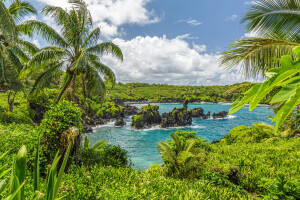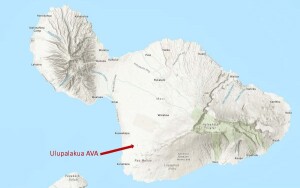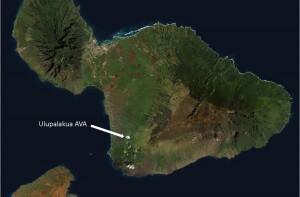 Here’s a first: Hawaii gets its very own American Viticultural Area (AVA)!
Here’s a first: Hawaii gets its very own American Viticultural Area (AVA)!
Despite being located in the tropics (the AVA itself sits at about 20°N latitude) and not being particularly well-known for grape-based viticulture or wine production, here it is: an AVA located in a small corner of the island of Maui—where grapes are grown and sent to a winery just a few miles away to be made into wine.
The Ulupalakua AVA is the first AVA to be approved in the state of Hawaii. When the new AVA comes into force on August 2, 2021, there will be a total of 257 AVAs in the United States.
According to the original petition for the AVA—submitted by Mark Beaman, the former winemaker at Maui Wines—the distinguishing features of area include its topography, soils, and climate, as discussed below:
Topography: The area within the Ulupalakua AVA contains a series of four distinct, southwest-facing areas of gently sloping benchlands. In contrast, the area surrounding the new AVA consists of steeper slopes, ravines, and exposed volcanic rock. The elevation of the vineyards in the AVA ranges from 1,560 feet/475 m (in the western portions) to 1,850 feet/564 m (in the east).
Soils: The Ulupalakua AVA is located on the western slopes of Mount Haleakala—a massive shield volcano that covers more than 75% of the island of Maui. The soils of the area are predominantly composed of volcanic ash and the weathered remains of igneous volcanic rock. About 20% of the soil contains silt, loam, and clay. It is believed that they combination of soils creates an area that is fertile enough to support healthy vines, but not so fertile as to promote excessive foliage.
Climate: The climate within the Ulupalakua AVA reflects its tropical location and rarely drops below 50°F/10°C or goes above 85°F/29°C. The region receives quite a bit of rain—an average of 30.7 inches of rainfall a year. However, it is noted that less than two inches per month tend to fall in July and August. While humidity can certainly be seen as an issue, this period of low summer rainfall reduces the risk of mildew and rot in the days leading up to the harvest, and the mild summertime temperatures protect again sunburn and heat stress.
It is believed that viticulture began in the area in the early 1800s when an immigrant from Portugal—Don Francisco de Paula Marin—imported vines into the region and made small amounts of wine. These days, the total area within the Ulupalakua AVA comprises 70 acres; of these, 16 acres are currently under vine. Leading grape varieties include Gewurztraminer, Chenin Blanc, Viognier, Grenache, Malbec, and Syrah. There is currently one commercial vineyard— Ulupalakua Vineyards owned by Maui Wine LLC—in the region. There are no bonded wineries within the AVA, but grapes are often sent to Maui Winery (located about just a few miles away) for processing.
The name “Ulupalakua” is derived from the native language of Hawaii and may be loosely translated as “breadfruit ripened on the back.” The folklore of the area tells of how the island’s king would request that his favorite fruit—breadfruit—be brought to his home on the west coast of Maui. Harvesters would pick the unripe fruit on the island’s eastern side and carry it to the king’s house on the other side of the island. The fruit would ripen on the journey and would be totally ripe by the time they reached (the area now known as) Ulupalakua.
References/for more information:
- Federal Register – Establishment of the Ulupalakua AVA
- Petition to Establish the Ulupalakua AVA
- Petition-Exhibits-Ulupalakua AVA
- https://mauiwine.com/
Post authored by Jane A. Nickles…your blog administrator: jnickles@societyofwineeducators.org


Hello Jane
This is so exciting to see so thanks for sharing. I recently visited Maui Wine and have written an article about Hawaii wineries and there history. You can find it here
https://blog.suvie.com/a-beginners-guide-to-hawaiian-wines/
FYI thanks to your excellent class and book I pasted the CSW exam last December